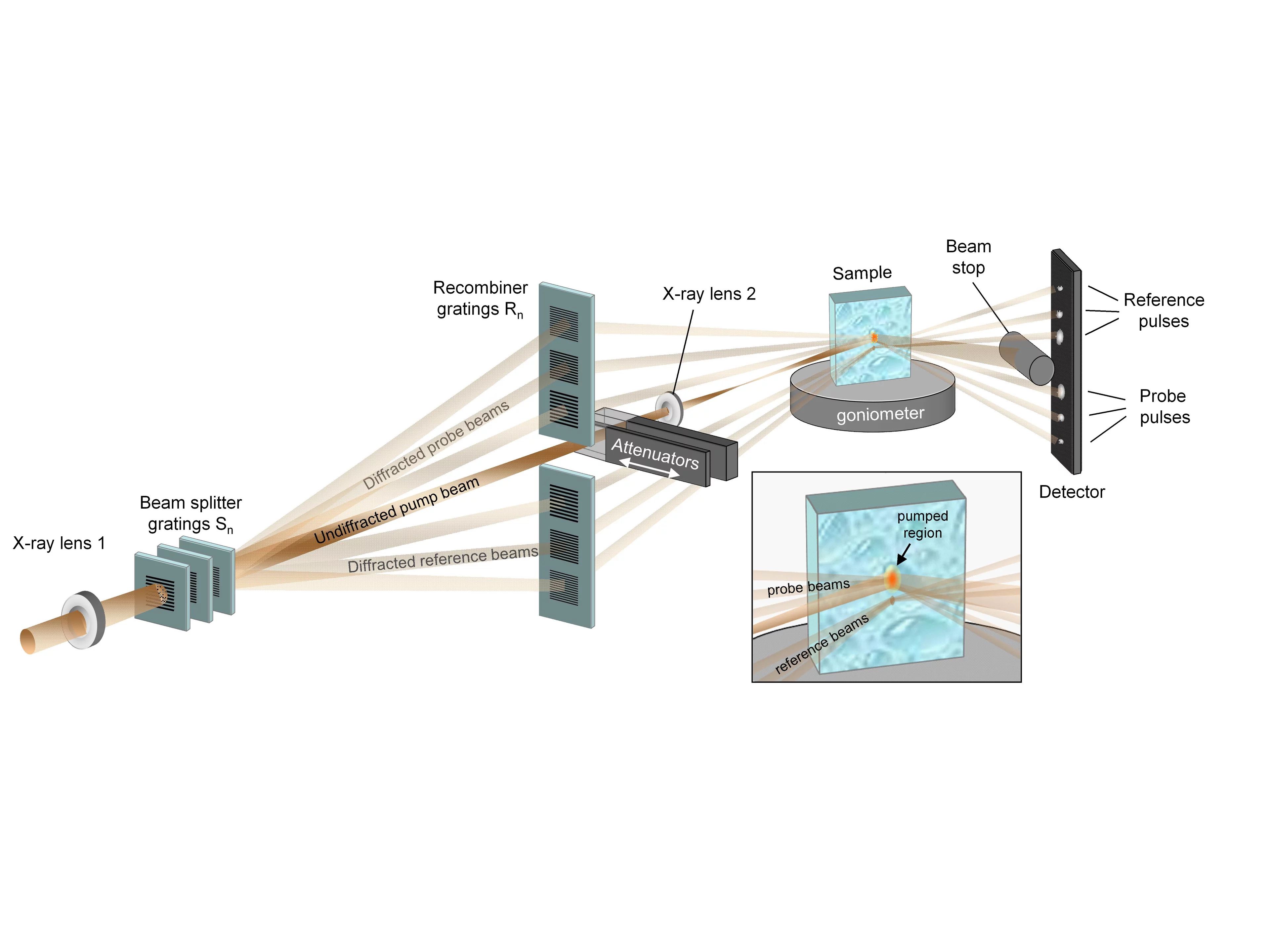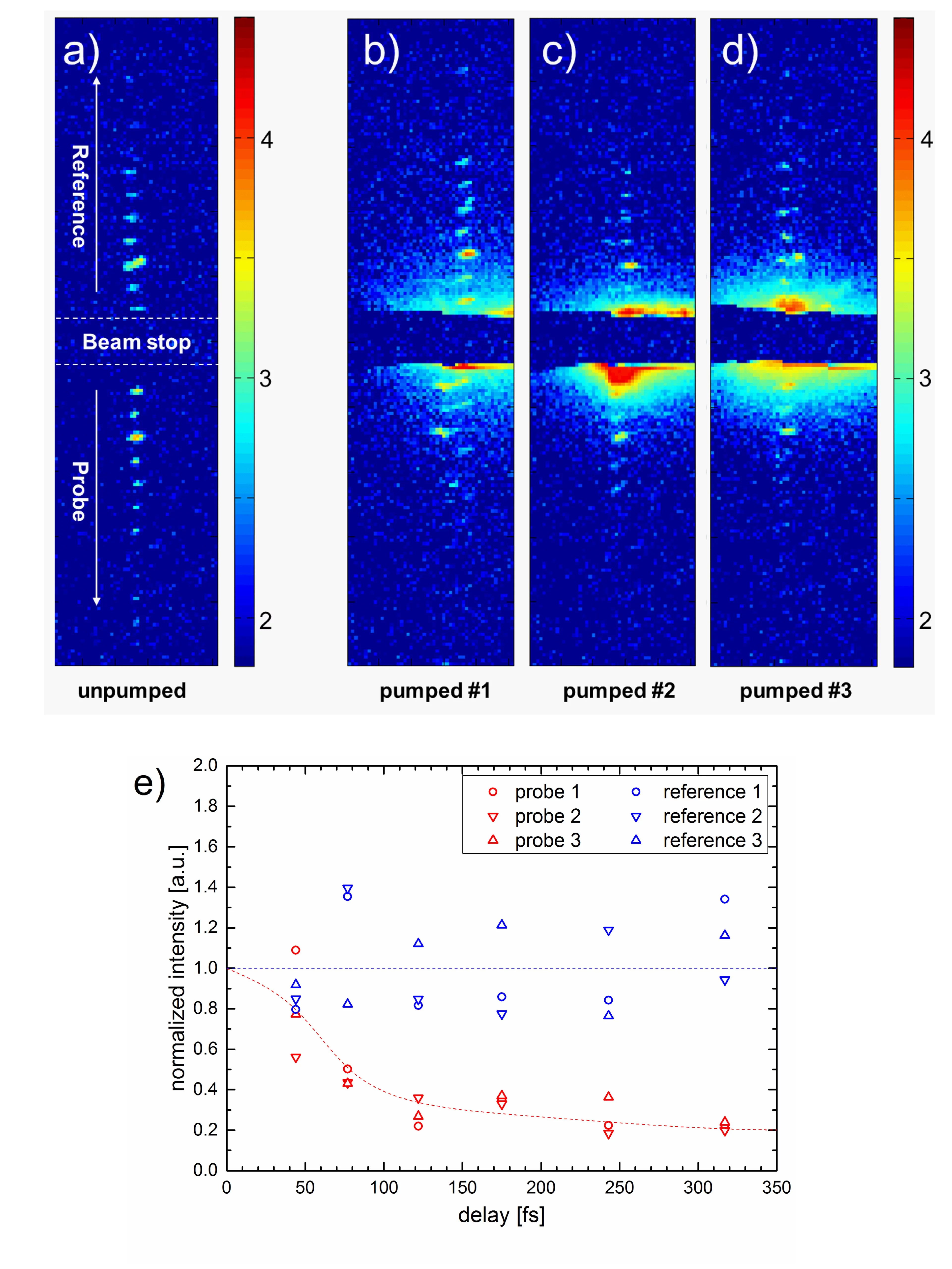Due to their femtosecond time structure, XFELs are successfully used for the investigation of ultrafast phenomena. In such pump-probe measurements, the sample is excited by a a short „pump“ pulse and then probed by a second „probe“ pulse after a certain delay time. Therefore, the sample's full dynamics must be obtained by repeating multiple measurements at different delay times. We (X-Ray Optics Group @ LMN, with support of cSAXS Beam line & Detector Group @ SLS and SwissFEL) developed a novel delay line based on diffraction gratings. It splits several beams from an XFEL pulse and recombines them at the sample. Each undiffracted (pump) pulse is therfore followed by a sequence of diffracted beams with precisely defined delays. Downstream of the sample, the beams separate again and can be recorded on an x-ray detector array. In addition to the probe beams, we also create a series of reference beams with the same delays, that hit the sample in an unpumped region. The schematic figure shows only 3 diffracted beam pairs for simplicity – corresponding to three different delay times. In our LCLS experiment, we created up to 15 probe and reference beam pairs (Figure 1).
Technically, the main challenge lies in the grating fabrication. The beam splitter gratings must be made from diamond in order not to be destroyed by the beam. The grating lines must be extremely fine to get delay times up to 1 ps, this required gratings with periods down to 17 nm. In addition, the setup must be fairly Long. We used a distance of 12.2 m between the first grating and the sample. In an experiment at LCLS, we observed how the Bragg reflectivity of a crystal changes after being pumped by the undiffracted XFEL pulse. Each data point in the plot represents a beam diffracted by the gratings. While the signal from the reference beams reflected from an unpumped region on the sample stays essentially constant, the probe signals from the pumped region drops with a half-time of about 50 fs, as the crystal structure is destroyed by the pump pulse. This represents the very first „single pump – multiple probe“ experiment, showing that the time trace of irreversible, destructive processes can be observed [1,2].
Similar experiments on the de-magnetization dynamics of ferromagnets [3] and on the damage processes on protein crystals [4] have been performed.
Publications
- C. David, P. Karvinen, M. Sikorski, I. Vartiainen, S. Song, C.J. Milne, A. Mozzanica, Y. Kayser, A. Diaz, I. Mohacsi, G. Carini, S. Herrmann, E. Färm, M. Ritala, D.M. Fritz, and A. Robert, Following the dynamics of matter with femtosecond precision using the X-ray streaking method, Scientific Reports 5 (2014) p. 7644
- M. Makita, I. Vartiainen, I. Mohacsi, C. Caleman, A. Diaz, O. Jonsson, P. Juranic, N. Medvedev, A. Meents, A. Mozzanica, N. Opara, C. Padeste, V. Panneels, V. Saxena, M. Sikorski, S. Song, L. Vera, P. Willmott, P. Beaud, C. Milne, B. Ziaja-Motyka, and C. David, X-ray induced non-thermal melting of Bismuth at femto-second time scales,Scientific Reports 9 (2018) p. 602, DOI:10.1038/s41598-018-36216-3
- M. Buzzi, M. Makita, L. Howald, A. Kleibert, B. Vodungbo, P. Maldonado, J. Raabe, N. Jaouen, H. Redlin, K. Tiedtke, P.M. Oppeneer, C. David, F. Nolting, J. Lüning, Single-shot Monitoring of Ultrafast Processes via X-ray Streaking at a Free Electron Laser, Scientific Reports 7 (2017) p. 7253, DOI: 10.1038/s41598-017-07069-z
- N. Opara, I. Mohacsi, M. Makita, D. Castano-Diez, A. Diaz, P. Juranic, M. Marsh, A. Meents, C. Milne, C. Padeste, V. Panneels, M. Sikorski, S. Song, H. Stahlberg, I. Vartiainen, L. Vera, M. Wang, P. Willmott, C. David, Demonstration of femtosecond X-ray pump X-ray probe diffraction on protein crystals, Structural Dynamics 5 (2018) p. 054303-9, DOI: 10.1063/1.5050618



